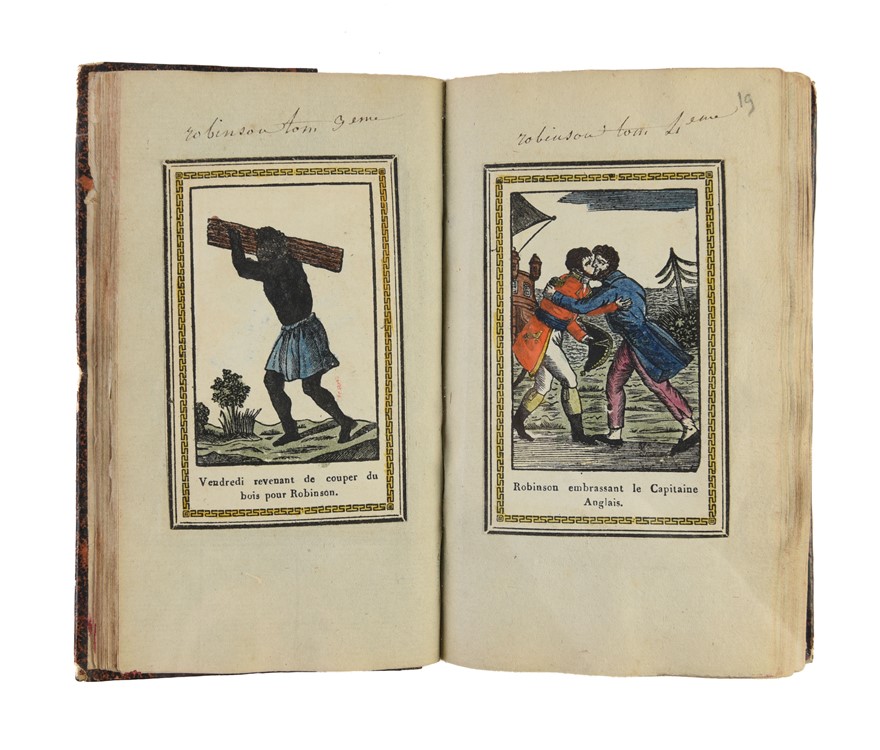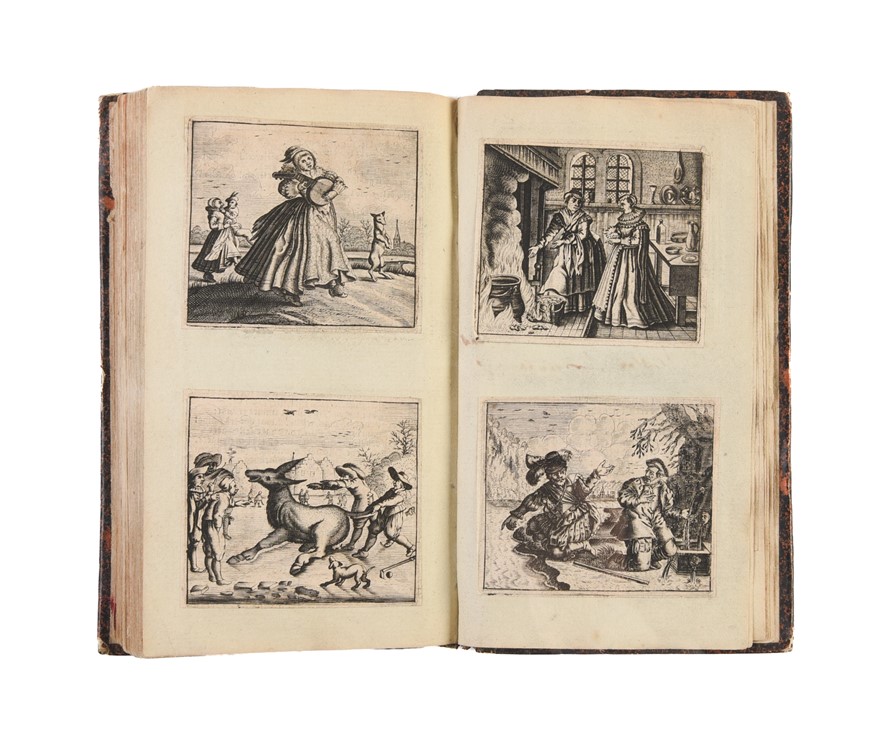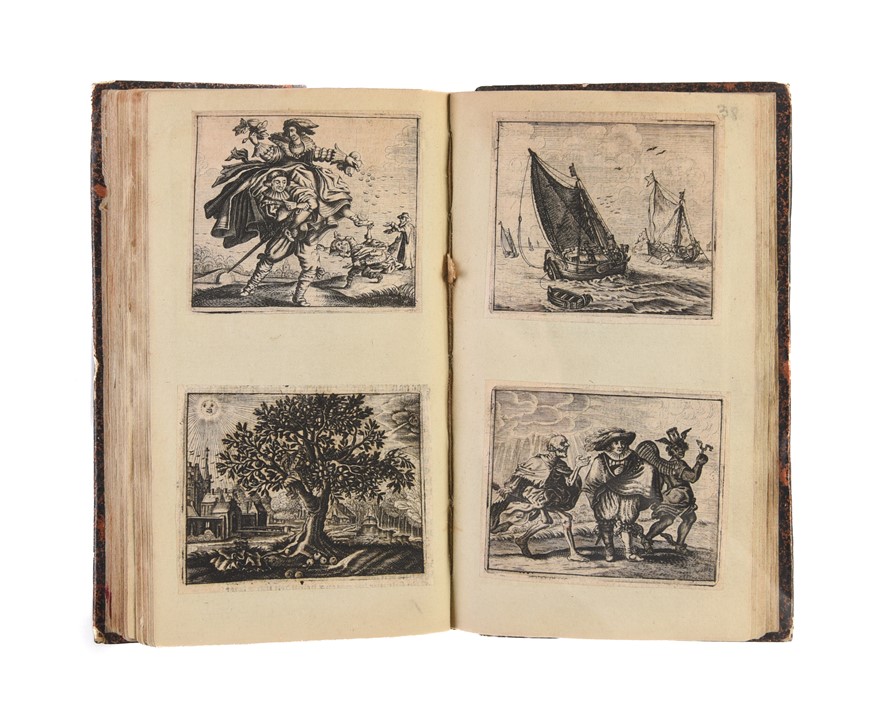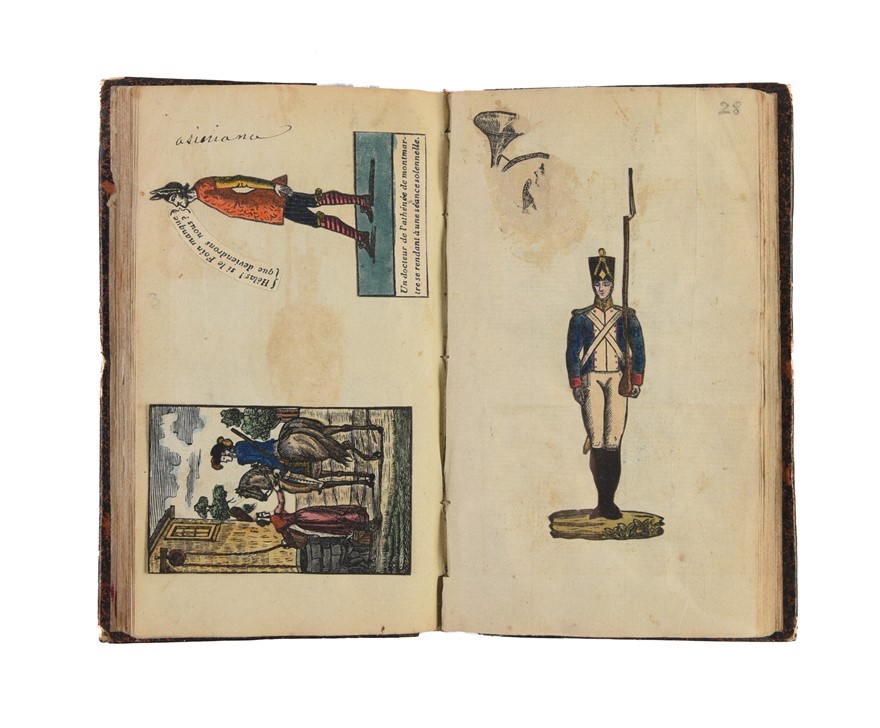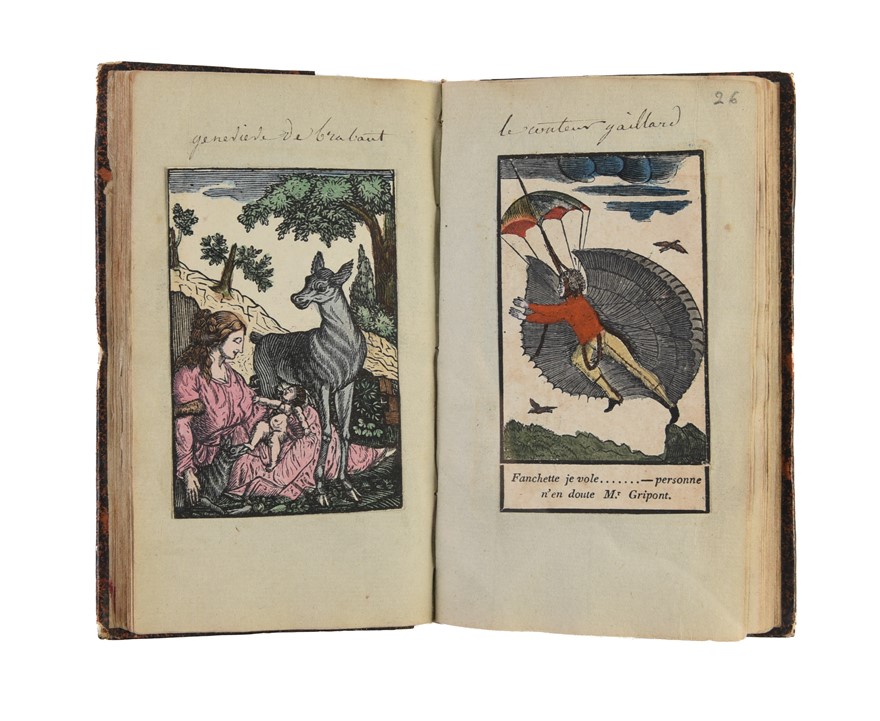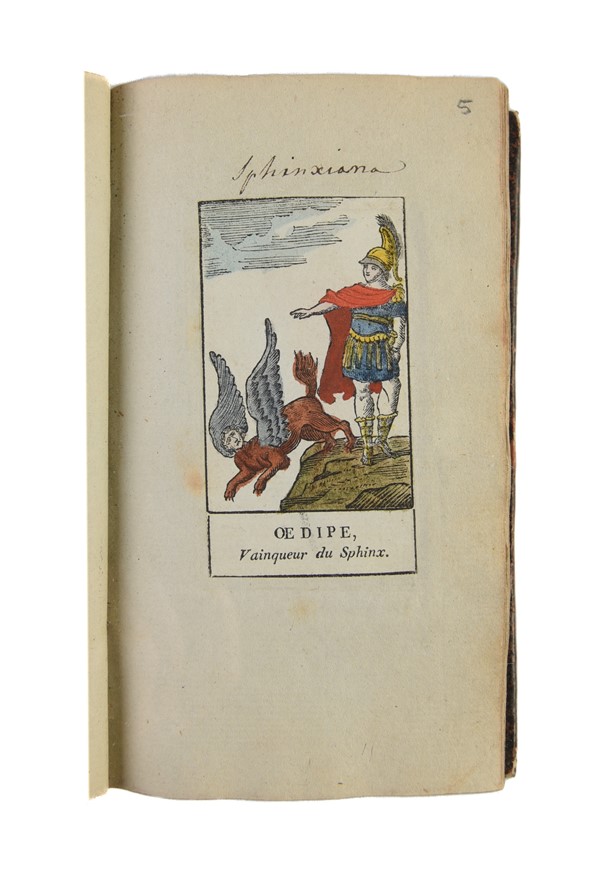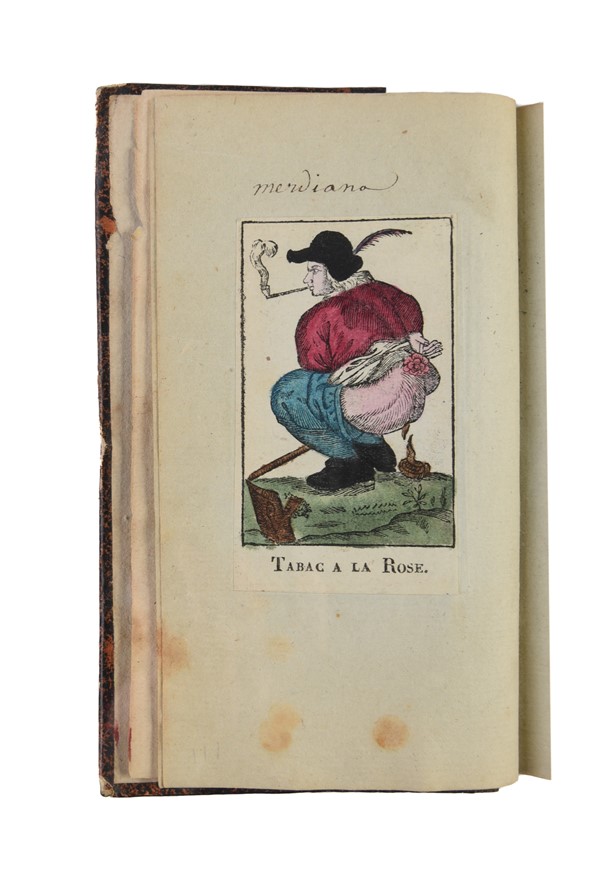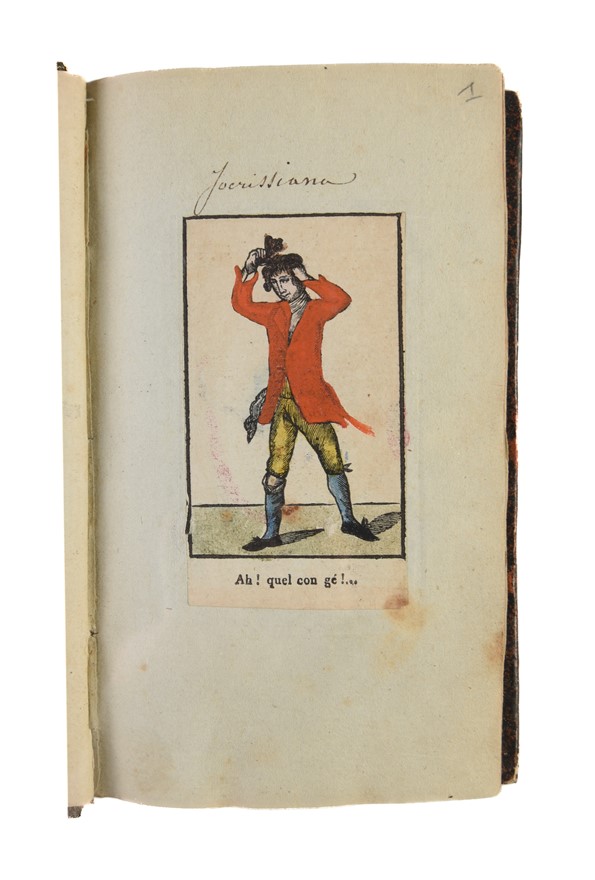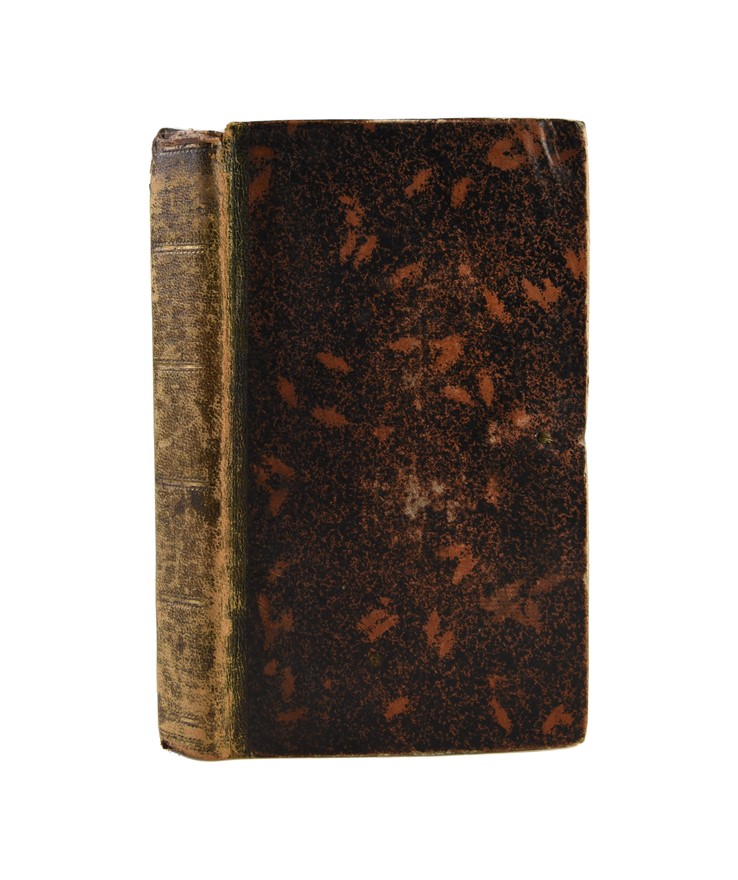Scrapbook of hand-coloured cuttings from ephemeral print, and emblematic engravings.
BLOCQUET Simon Francois; CATS Jacob (1820)
£1750.00
Available to view at our Curzon Street shop.
ROBINSON CRUSOE, CINDERELLA & DUTCH EMBLEMS - RECYCLING POPULAR PRINT
8vo (160 x 100mm). ff.[71], of which ff.[62], numbered in pencil in later hand, contain pasted images, first half French, early C19th hand-coloured woodcuts, second half C17th Dutch emblematic engravings. Nineteenth-century, quarter-bound green morocco over red and black speckled paper-covered boards, spine simply gilt, pink silk page marker, lacking green ties (rubbing to upper and lower boards, headcap chipped).
France [?Lille], c.
A highly visual album of popular prints and emblematic engravings, anonymously cut, pasted, compiled and labelled by hand in the early nineteenth century. Pasted one to a blank page - with some evidence of removals and rearrangements - the contents of this volume are arranged in three parts. The first 33 leaves contain hand-coloured images removed from French livrets de colportage, chapbooks, and single-sheet ephemera; the second portion contains engravings from a popular seventeenth-century emblem book, Jacob Cats' Spiegel van den ouden ende nieuwen tijdt (first printed in The Hague, 1632). The last few pages contain images of military figures on horseback and on foot.
This scrapbook is both a personalised record of an individual's consumption of popular print, and a valuable record of French illustrated ephemera. The illustrations in the first half of the volume are on a variety of subjects and depict a range of historic, contemporary and fictional figures. Present here are scenes from Robinson Crusoe (ff.17v-19r); the fables of Jean Pierre Claris de Florian (ff.19v-21r); French vaudeville - Monsieur et Madam Denis (f.11v) - as well as scenes from the story of medieval saint Genevieve de Brabant (f.25v) and Cinderella (f.9v). Among other figures are Bacchus and his followers ('vive le vin, vive l'amour', f.29v, f.10v) and satirical representations of 'stock' figures like doctors (f.3v, f.27v) and a gourmand (f.4r). Well-known, near-contemporary figures are also represented here, including Alexis Piron (1689-1773) dramatist and writer of bon mots, and Brule Maison, or François Decottignies (1679-1740), popular chansonniere from Lille.
Many of these illustrations can be traced to the presses of Lille printer Simon François Blocquel (1780-1863). Printer, in partnership with Jean Baptiste Castiaux of livres de colportage - chapbooks, almanacs, chansonniers, illustrated travel accounts, devotional handbooks and children's books, among many others - Blocquel was prolific. The ephemeral nature of his output has meant a low survival rate for many of his works, but we have been able to identify the sources for several of these illustrations thanks to the handwritten inscriptions above some of the images. The four woodcuts of Robinson Crusoe are taken from Blocquel's four-volume Les Aventures de Robinson Crusoe (1820), described as 'orné de huit jolie gravures', and with these images illustrating the wrappers of each volume; that of Oedipus is the frontispiece to Blocquel's Sphinxiana: ou, Recueil Curieux d’Enigmes, de Charades et de Logogriphes (Lille: Blocquel, 1814). The images on 30v and 31r are attributable to Blocquel, and to the engraver Henri Desire Porret (1800-1867). There is great scope for further research to identify more, if not all of the images pasted here, and thus piece together a picture of one individual's consumption of popular print in the early nineteenth century. While often associated with quantity rather than quality, necessarily, such images importantly 'plunge us into the cultural word inhabited by the majority of the French population in the nineteenth century' (Collins, p.237).
The second part of the volume contains the title engraving and emblems cut from an 8vo edition of Jacob Cats' Spiegel van den ouden ende nieuwen tijdt, or 'Mirror of Old and New Times'. One of the most popular emblem books of the seventeenth century, many of the mottos accompanying Cats' evocative engravings became household sayings; the man depicted in f.54v, for example, is cutting off his nose to spite his face, and so on. The illustrations here, all with a crisp, strong impression, are from the same plates used to illustrate the first 8vo edition of the text (Dordrecht: Hendrick van Esch, 1633) though do not appear to be from that particular edition; some here are also accompanied by the text of the mottos, printed in polyglot. Interestingly, the emblems here have been pasted in a different order to that found in the printed text - presumably in a way that made more sense to the owner of this book, or indeed that might impart important moral lessons to a young reader. There is an instructive quality to the second half of this volume that might indicate that it was compiled by a different hand to the first.
First leaf - depicting a Harlequin - removed (some time ago), some offsetting, otherwise in very good condition.
For Catz emblems see Landwehr, Dutch, 46. D. J. Collins, 'Simon Blocquel, imagier et éditeur lillois', Journal de la societé des océanistes (1985), 81, pp.235-40.
Stock Code: 251656
